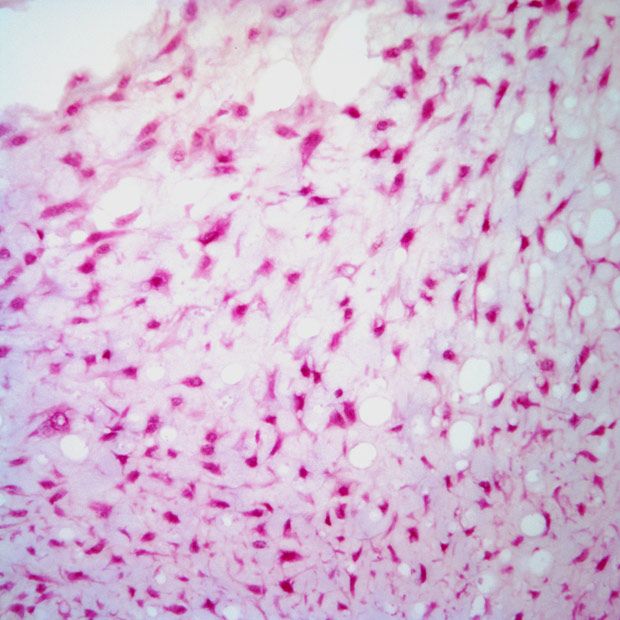Lete-cel Earns FDA Breakthrough Therapy Designation in Pretreated MRCLS
In the IGNYTE-ESO trial, letetresgene autoleucel elicited an ORR of 43%, a median PFS of 7.7 months, and a median DOR of 12.2 months in those with MRCLS.
In the IGNYTE-ESO trial, letetresgene autoleucel elicited an ORR of 43%, a median PFS of 7.7 months, and a median DOR of 12.2 months in those with MRCLS.

Letetresgene autoleucel (lete-cel) has been granted breakthrough therapy designation from the FDA for patients with unresectable or metastatic myxoid/round cell liposarcoma (MRCLS) who have also received prior anthracycline-based chemotherapy, are positive for human leukocyte antigen (HLA)-A*2:01, HLA-A*02:05, or HLA-A*02:06, and whose tumor expresses the New York esophageal squamous cell carcinoma 1 (NY-ESO-1) antigen, according to a press release from the developer, Adaptimmune Therapeutics.1
Additional information about the developer’s lete-cel clinical program will be shared at the Annual J.P. Morgan Healthcare Conference in January 2025.
The FDA’s decision was based on data from the MRCLS portion of the phase 2 IGNYTE-ESO trial (NCT03967223) that set out to evaluate the safety and efficacy of T-cell therapies in patients with advanced tumors.
"This designation by the FDA highlights the potential of lete-cel to address a critical need for new treatment options for patients with MRCLS,” Adrian Rawcliffe, chief executive officer of Adaptimmune, said in the press release.1 “This is another important milestone in building out our sarcoma franchise, as we aim to bring lete-cel to market in 2026 for the treatment of synovial sarcoma and MRCLS. We look forward to initiating a rolling biologics license application for lete-cel later this year for the treatment of both sarcoma indications."
In the trial, the overall response rate (ORR) across the MRCLS population was 43% (n = 13/30; 95% CI, 25.5%-62.6%); 10% showed complete responses, 33% showed partial responses, 53% had stable disease, and 3% had progressive disease.2 The median duration of response (DOR) was 12.2 months (95% CI, 5.3-not evaluable [NE]), and the median progression-free survival (PFS) was 7.7 months (95% CI, 5.2-9.2)
Regarding adverse events (AEs), data specific to the MRCLS population alone were not available, although the most common treatment-emergent T cell-related AEs of any grade and grade 3 or higher in the overall trial population were cytokine release syndrome (92% and 12%, respectively), rash (64% and 35%), neutropenia (45% and 42%), anemia (39% and 33%), and thrombocytopenia (35% and 30%).
Lymphodepletion-related AEs of any grade and grade 3 or higher in the overall trial population occurred in 98% and 89% of patients; the most common were neutropenia (73% and 73%, respectively), thrombocytopenia (64% and 48%), anemia (62% and 44%), leukopenia (48% and 47%), and febrile neutropenia (29% and 27%).
The primary trial end point was ORR per RECIST v1.1 criteria via independent central review. Secondary end points were safety, ORR by investigator assessment, time to response, DOR, disease control rate, PFS, and overall survival.
Of the overall trial population of 64 patients, 47% (n = 30) of patients had MRCLS, 100% had received anthracycline chemotherapy prior to lymphodepletion, and 98% had metastatic disease at screening.
Eligible patients were 10 years or older and had HLA-A*2:01–, HLA-A*02:05–, or HLA-A*02:06–positive, NY-ESO-1–expressing metastatic or unresectable MRCLS. They also had to have started anthracycline-based chemotherapy before apheresis, progression on their last prior line of therapy and measurable disease per RECIST v1.1 guidelines before lymphodepletion, and an ECOG performance status of 0 or 1.
Patients received 1 to 15 x109 transduced cells of lete-cell, 120 mg/m2 of fludarabine, and 2700 to 3600 mg/m2 of cyclophosphamide cumulatively over 3 to 4 days.
"Individuals with both synovial sarcoma and MRCLS are commonly diagnosed under 40 [and have] a devastating disease with limited treatments in the prime of their lives,” Sandra D'Angelo, MD, a medical oncologist and cell therapist at Memorial Sloan Kettering Cancer Center, stated in a press release on findings from the IGNYTE-ESO trial.3 “I’ve been seeing these patients throughout my career and have frequently faced the frustrating reality of having incredibly limited treatment options to offer them. I’m encouraged by these data as they could lead to a potential therapeutic option and an improved prognosis for these patients."
References
- Adaptimmune announces U.S. FDA breakthrough therapy designation granted to letetresgene autoleucel (lete-cel) for treatment of myxoid/round cell liposarcoma (MRCLS). News release. Adaptimmune. January 13, 2025. Accessed January 14, 2025. https://tinyurl.com/9v4sm7ek
- D’Angelo SP, Furness A, Thistlethwaite F, et al. Primary analysis of the pivotal IGNYTE-ESO trial of lete-cel in patients with synovial sarcoma or myxoid/round cell liposarcoma. Presented at: 2024 CTOS Annual Meeting. November 13-16, 2024; San Diego, California. Abstract P84.
- Adaptimmune's lete-cel achieves primary endpoint in pivotal trial. News release. Adaptimmune. November 13, 2024. Accessed January 14, 2025. https://tinyurl.com/4jmn5tyn
Newsletter
Stay up to date on recent advances in the multidisciplinary approach to cancer.
Sarcoma Awareness Month 2023 with Brian Van Tine, MD, PhD
August 1st 2023Brian Van Tine, MD, PhD, speaks about several agents and combination regimens that are currently under investigation in the sarcoma space, and potential next steps in research including immunotherapies and vaccine-based treatments.






